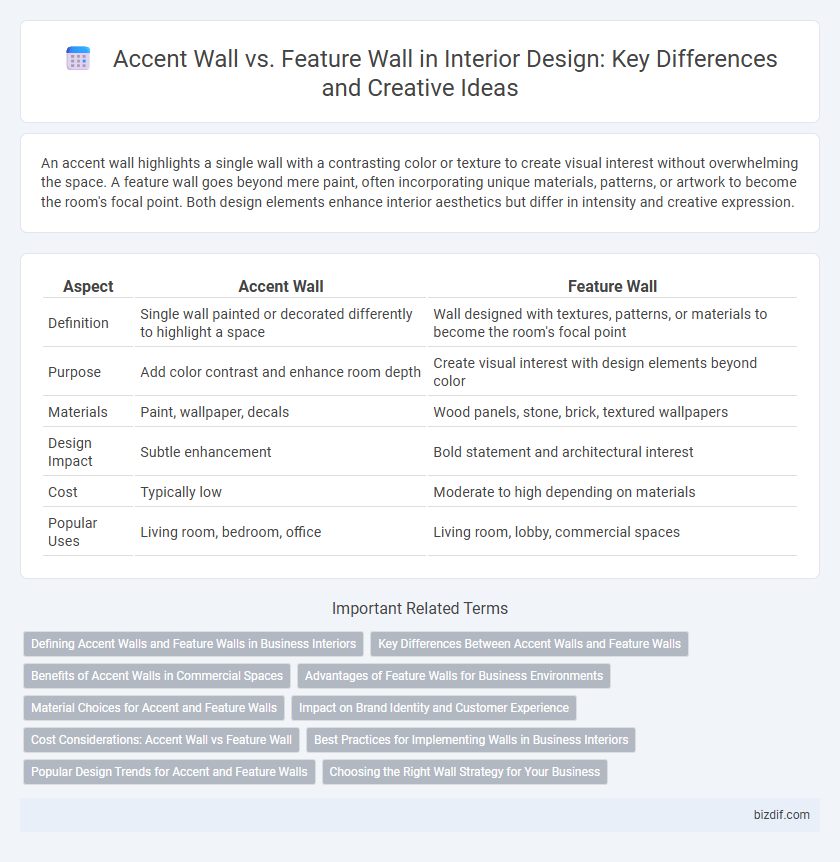An accent wall highlights a single wall with a contrasting color or texture to create visual interest without overwhelming the space. A feature wall goes beyond mere paint, often incorporating unique materials, patterns, or artwork to become the room's focal point. Both design elements enhance interior aesthetics but differ in intensity and creative expression.
Table of Comparison
| Aspect | Accent Wall | Feature Wall |
|---|---|---|
| Definition | Single wall painted or decorated differently to highlight a space | Wall designed with textures, patterns, or materials to become the room's focal point |
| Purpose | Add color contrast and enhance room depth | Create visual interest with design elements beyond color |
| Materials | Paint, wallpaper, decals | Wood panels, stone, brick, textured wallpapers |
| Design Impact | Subtle enhancement | Bold statement and architectural interest |
| Cost | Typically low | Moderate to high depending on materials |
| Popular Uses | Living room, bedroom, office | Living room, lobby, commercial spaces |
Defining Accent Walls and Feature Walls in Business Interiors
Accent walls in business interiors highlight a single wall with contrasting colors or textures to create visual interest and brand identity without overwhelming the space. Feature walls incorporate distinctive elements such as murals, shelving, or lighting installations, serving both aesthetic and functional purposes by enhancing the overall design narrative. Choosing between accent and feature walls depends on desired impact, with accent walls emphasizing color and simplicity while feature walls offer multidimensional design focal points.
Key Differences Between Accent Walls and Feature Walls
Accent walls typically highlight a single wall using contrasting colors, textures, or materials to create visual interest without dominating the space. Feature walls, on the other hand, often incorporate elaborate designs, patterns, artwork, or unique architectural elements that serve as a focal point within a room. Understanding these key differences helps interior designers select the best wall treatment to balance aesthetics and functionality in various spaces.
Benefits of Accent Walls in Commercial Spaces
Accent walls in commercial spaces enhance brand identity by incorporating company colors and logos, fostering a cohesive and memorable environment. They create focal points that guide customer flow and draw attention to key areas, boosting engagement and sales opportunities. Using textured materials or bold colors on accent walls also improves spatial perception, making interiors appear more dynamic without overwhelming the overall design.
Advantages of Feature Walls for Business Environments
Feature walls in business environments enhance brand identity by incorporating company colors, logos, or thematic artwork, creating a visually cohesive space. They provide focal points that improve spatial orientation and customer engagement, making reception areas and meeting rooms more inviting. These walls also offer flexibility for displaying promotional materials or seasonal decor, supporting dynamic marketing strategies within the workplace.
Material Choices for Accent and Feature Walls
Materials for accent walls often include textured wallpaper, reclaimed wood, and bold paint finishes that create focal points through tactile or color contrast. Feature walls typically utilize premium materials like natural stone, exposed brick, or decorative panels to highlight architectural elements and add depth. Selecting materials with distinct textures, durability, and visual impact enhances the overall aesthetic and functionality of both accent and feature walls in interior design.
Impact on Brand Identity and Customer Experience
An accent wall enhances brand identity by incorporating signature colors or textures that reinforce visual consistency and emotional connection, making spaces more memorable for customers. Feature walls often use bold graphics or thematic elements to create immersive experiences that actively engage visitors and communicate core brand messages. Both strategies elevate customer experience but vary in intensity and focus, with accent walls offering subtle reinforcement and feature walls delivering dramatic storytelling.
Cost Considerations: Accent Wall vs Feature Wall
Accent walls generally involve simpler design elements and limited paint or materials, making them more cost-effective compared to feature walls, which often require intricate patterns, textured finishes, or specialty treatments that increase overall expenses. The choice between an accent wall and feature wall significantly impacts budget allocation, as feature walls may also demand professional installation and higher-quality materials, raising labor and material costs. Evaluating the balance between aesthetic impact and project costs helps homeowners or designers make informed decisions tailored to budget constraints within interior design projects.
Best Practices for Implementing Walls in Business Interiors
Accent walls in business interiors utilize contrasting colors or textures to create visual interest and draw attention to specific areas, enhancing brand identity. Feature walls often incorporate artwork, branding elements, or textured materials to communicate the company's values and create focal points in reception or meeting spaces. Best practices include selecting materials and colors aligned with the business's color palette, ensuring durability for high-traffic areas, and balancing bold design with overall spatial harmony.
Popular Design Trends for Accent and Feature Walls
Popular design trends for accent and feature walls emphasize bold color contrasts and textured materials such as reclaimed wood, stone, or patterned wallpaper to create focal points in living spaces. Incorporating geometric shapes, metallic finishes, and nature-inspired murals enhances visual interest and personal expression in both residential and commercial interiors. Contemporary designs often blend functionality with aesthetics by integrating built-in shelving or lighting to accentuate these striking wall treatments.
Choosing the Right Wall Strategy for Your Business
Selecting between an accent wall and a feature wall depends on your business's branding and spatial dynamics. Accent walls typically emphasize a single color to create contrast and draw attention subtly, while feature walls incorporate textures, patterns, or artwork to become a focal point with more visual interest. Consider the desired customer experience and overall design harmony when choosing the wall strategy to effectively enhance brand identity and employee productivity.
Accent wall vs Feature wall Infographic

 bizdif.com
bizdif.com